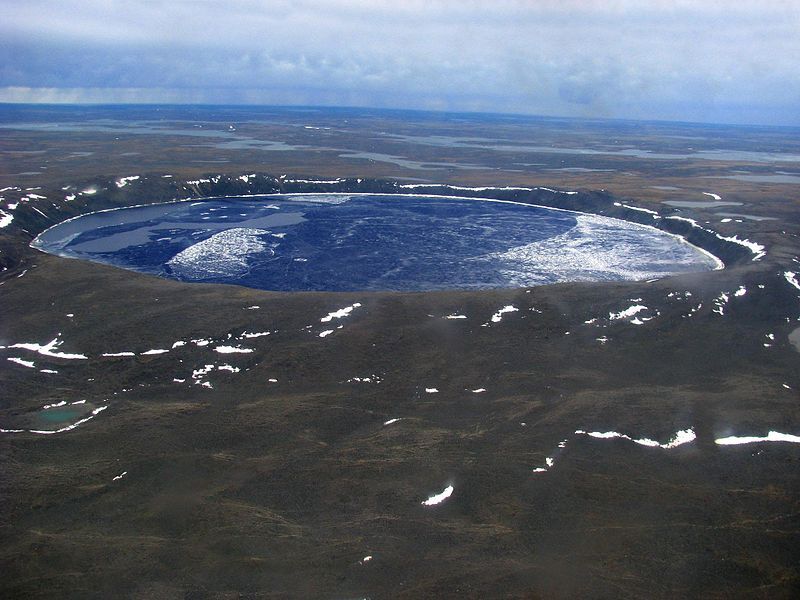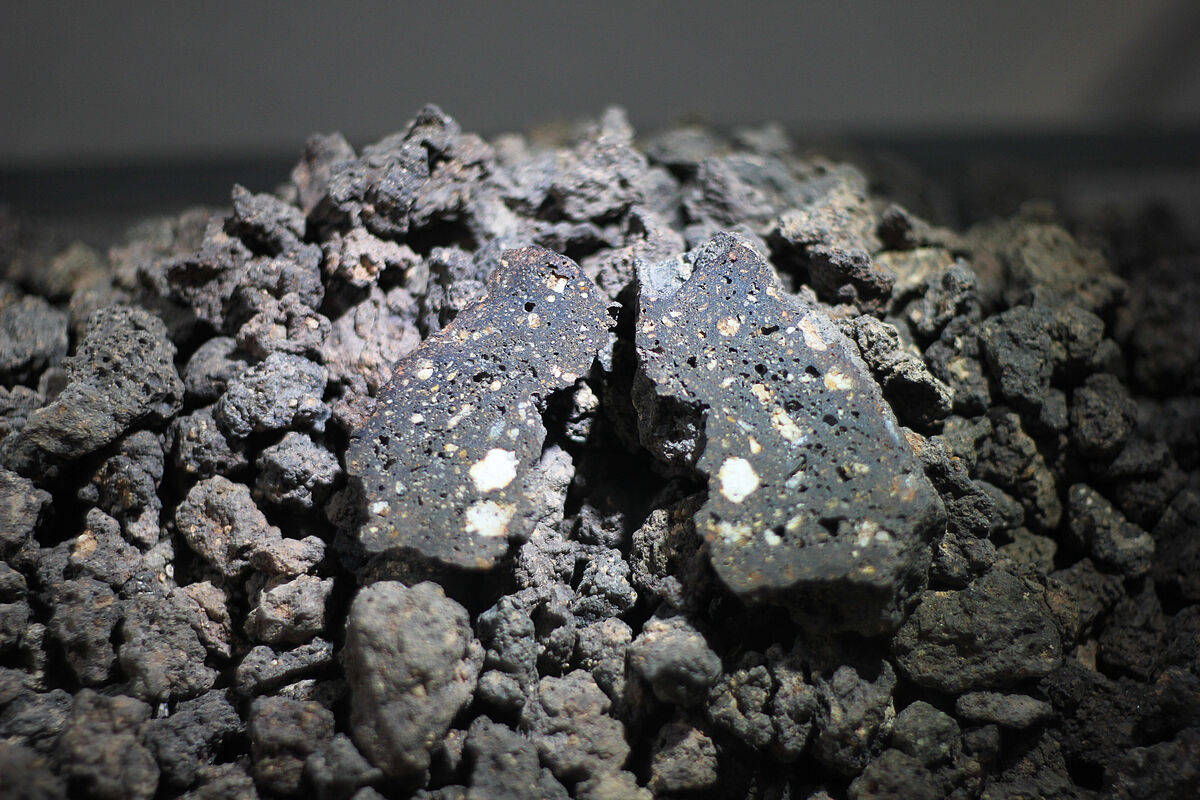A meteoroid impact is the collision of a large meteorite with the Earth’s surface.
Disintegrating comets and asteroid collisions result in an abundance of dust and debris of rocky or metallic material floating in space. This debris ranges in size and is called meteoroids. As the Earth revolves around the Sun, it regularly comes into contact with meteoroids. Attracted by the Earth’s gravity, they enter the atmosphere at very high speeds. It is important to know the difference between certain terms in order to understand this phenomenon.
A meteor is a meteoroid that disintegrates completely upon entering the Earth’s atmosphere. Meteors are commonly referred to as shooting stars.
Most of the debris entering the Earth’s atmosphere does not hit the Earth’s surface. The friction of the debris against gas molecules in the atmosphere causes it to disintegrate. This process releases a large amount of energy in the form of light. The matter making up the debris lights up at the same time as the surrounding air. This debris moves at a very high speed and leaves a trail of light behind it, which is why meteors are often called shooting stars.

It is possible to look up and see a shooting star any night of the year, but there are certain times when the viewing is best. These events are called meteor showers. They normally happen when the Earth crosses the orbit of a comet. The debris left behind enters the Earth’s atmosphere and immediately disintegrates, creating several visible trails of light over a short period. Meteor showers are named after constellations. In Quebec, the Perseids from the constellation Perseus can be observed in mid-August and Leonids from the constellation Leo in November.
Very small meteors, about the size of a pea, are normally completely destroyed upon entering the atmosphere. Larger rock fragments are not entirely destroyed and can land on the Earth’s surface. These are called meteorites.
A meteorite is a solid stony or iron meteoroid that reaches the surface of the Earth or another celestial body, such as a planet, natural satellite or asteroid.
When a meteoroid does not completely disintegrate in the Earth’s atmosphere before reaching the ground, it becomes a meteorite. While friction with the air slows down these objects and causes them to partially disintegrate, they are still large enough to reach the Earth’s surface, travelling at high enough speeds to cause damage upon impact.
Between |10\ 000| and |1\ 000\ 000| tonnes of celestial objects are believed to fall to Earth each year. Most of them fall into the ocean but some hit land and can cause significant damage depending on the location of impact. Over |25\ 000| meteorites have been discovered around the world, |75\%| of which were found in Antarctica. The largest meteorite discovery to date is the Hoba meteorite, named after a farm in Namibia where it was found. It is an impressive block of iron and nickel weighing almost 60 tonnes.


Over 60 meteorites have been discovered in Canada. On June 14, 1994, in Saint-Robert-de-Sorel, Quebec, a spectacular meteor shower of stony meteorites accompanied by a sonic boom was observed. So far, 24 meteorite fragments have been found, with the largest one weighing over |6\ \text{kg}.| The meteorite had an estimated diameter of |40\ \text{metres}| before entering the atmosphere.
A meteoroid impact is a collision between the Earth and a large meteorite.
When a large meteorite with a width of hundreds or thousands of metres collides with the Earth’s surface at high speed |(36\ 000-54\ 000\ \text{km/h}),| it creates a hole in the ground. This hole is called a meteorite crater. The remains of ancient craters are also called astroblemes.
Fortunately, large meteorites rarely collide with Earth. Estimates suggest these collisions happen about every |1\ 000| years.
| Meteorite size | Approximate impact frequency |
| |1\ \text{mm}| | Every |30\ \text{seconds}| |
| |1\ \text{m}| | Every |\text{year}| |
| |10\ \text{m}| | Every |100\ \text{years}| |
| |100\ \text{m}| | Every |1\ 000\ \text{years}| |
| |10\ \text{km}| | Every |100\ \text{million years}| |
Meteoroid impacts sculpt the landscape. Upon impact, a shock wave travels through the ground. This wave always travels in concentric circles even when meteorites are irregularly shaped. As this wave travels, it deforms the Earth’s crust and can produce earthquakes and tidal waves.
A crater is generally twenty times larger than the meteorite that produced it. The Vredefort crater in South Africa is the largest and oldest in the world. It is |300\ \text{km}| in diameter and was formed over 2 billion years ago.
Many craters are difficult to detect because they have been partially concealed over time by erosion and sedimentation. Other solid celestial bodies in our solar system also contain meteorite craters.
Manicouagan astrobleme
The Manicouagan crater is one of the best examples of an impact crater in the world. It was created 214 million years ago at the end of the Triassic period by a meteorite |8\ \text{km}| in diameter. In a matter of seconds, a crater with a diameter of approximately |88\ \text{km}| was formed with a peak in the centre, which is known as Mount Babel today. This impact was also responsible for a mass extinction. Passing glaciers significantly eroded the Manicouagan crater. During the construction of the Daniel-Johnson hydroelectric dam, formerly known as Manic-5, the Manicouagan and Mouchalagane rivers were diverted, flooding the inner perimeter of the astrobleme. The shape of this complex crater is now very visible. Called the Eye of Quebec, it is the largest crater in Canada and is visible even from the moon.
Charlevoix astrobleme
The Charlevoix astrobleme is also a complex crater that experienced substantial erosion. About |58\ \text{km}| in diameter, this crater was created by a meteorite only |2\ \text{km}| in diameter and extends today from the Baie-Saint-Paul region to La Malbaie and Cap-à-l’Aigle. Almost half of the crater is hidden beneath the St. Lawrence River, and Mont des Éboulements is its central peak. This impact happened 360 million years ago.
Lac Couture astrobleme
The Lac Couture astrobleme in Nunavik was formed by a meteorite impact during the Silurian period about 450 million years ago. Lac Couture is circular in shape and |16\ \text{km}| in diameter. The meteorite crater, located in the northern part of the lake, is |12\ \text{km}| in diameter. The islands, located only in the southern part of the lake, contain crystal structures, molten rocks and other unique formations. A ridge of over 100 metres was eroded by passing glaciers.
Pingualuit astrobleme
The Pingualuit crater, from the Inuit word meaning pimple, is located on the Ungava Peninsula. It was discovered on June 20, 1943. Formerly known as the Nouveau-Québec crater, it is |3.44\ \text{km}| in diameter and was created by a meteorite impact about 1.4 million years ago, during the Pleistocene period. Lake Pingualuk formed inside the crater and contains water reserves with a salinity of less than |3\ \text{ppm}|—some of the purest water in the world. Clearer water can be found only in Lake Masyuko in Japan. At |252\ \text{m},| Lake Pingualuk is the deepest lake in Quebec.
Île Rouleau astrobleme
The Île Rouleau astrobleme is not visible since it is located in the southern part of Lac Mistassini in Quebec. Île Rouleau is the raised portion of the crater’s central peak. With a diameter of about |2\ \text{km},| the collision that created occurred approximately 300 million years ago during the Permian period.
Lac Wiyâshâkimî astroblemes
The craters of Lac Wiyâshâkimî, also called Lac à l’Eau Claire, respectively |36| and |26\ \text{km}| in diameter, are examples of complex craters. The central peak is visible, formed by a ring of islands in the bigger crater. The two craters are believed to have formed at the same time about |290 \pm 20| million years ago during the Permian period.
La Moinerie astrobleme
Lac La Moinerie is an impact crater |8\ \text{km}| in diameter located in Nunavik, Quebec. It is estimated to have been created |400 \pm 50| million years ago during the Silurian or Devonian periods. The crater’s ridge and central peak were eroded during the last ice age.
Lac de la Presqu’île astrobleme
The Lac de la Presqu’île crater is located near Chapais, Quebec. The impact occurred during the Cambrian period, and the crater was originally between |12| and |24\ \text{km}| in diameter. The circular form of Lac de la Presqu’île is the result of a meteorite impact from about 760 million years ago.
A huge amount of matter called ejecta is launched into the air during the collision of a meteorite with the Earth’s surface. Larger pieces fall back to the surface, partially covering the crater. If a meteorite is large enough, dust from the impact can be dispersed many kilometres up into the atmosphere, contaminating the air and concealing the Sun for years. This can greatly affect life on Earth and lead to mass extinctions. It is widely believed that such an event led to the extinction of dinosaurs.
Under extreme pressure and heat, the ejecta quickly transforms into a type of rock called impactite. Impactites contain minerals that form only due to intense pressure during a violent impact. They also contain glass, which is hard and highly resistant to erosion. The presence of impactites in a given area is an indicator that a meteorite impact occurred there.






